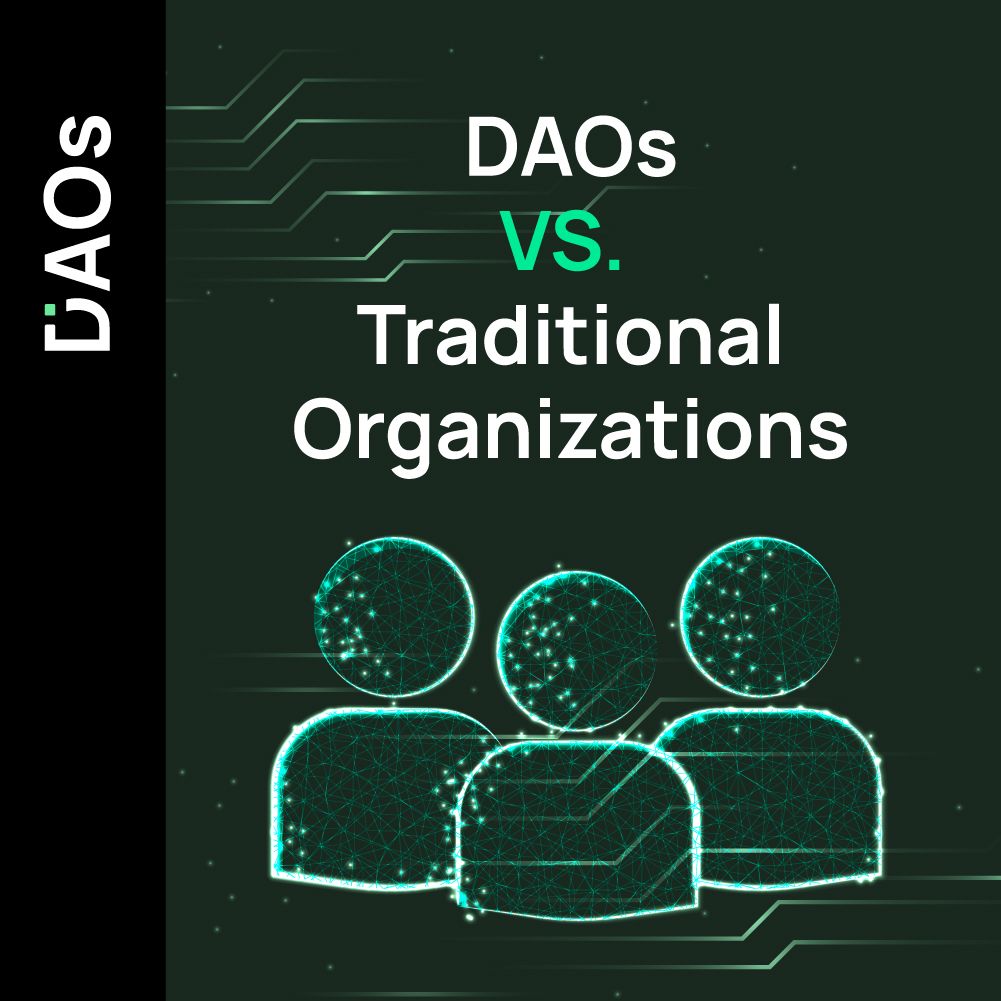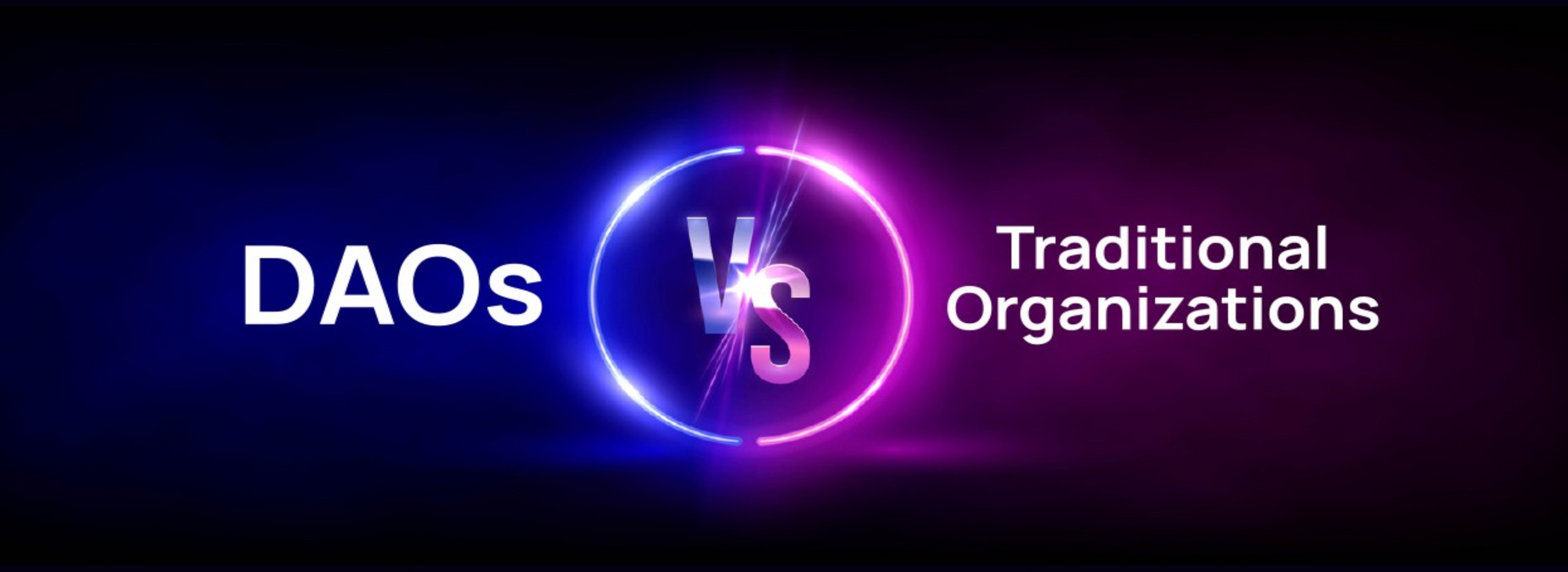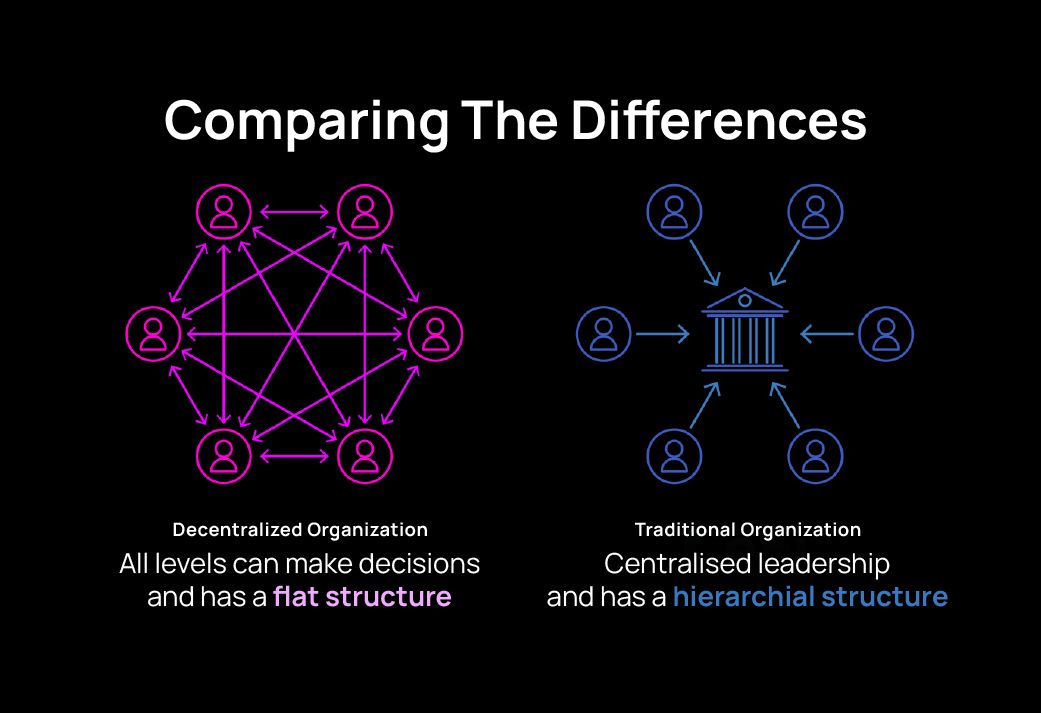12: DAOs (Decentralized Autonomous Organizations) vs. Traditional Organizations

Traditional organizations are characterized by a pyramidal structure, with maximum power resting in the hands of the highest official. On the other hand, DAOs are quite the opposite, with a flat hierarchy where every member has an equal say.
At its core, DAOs are revolutionary, set to challenge every conventional notion about organization building and the role of its management.
This article compares the various aspects of DAOs and traditional organizations to understand the fundamentals of how the two differ.
What is a DAO?
A DAO or decentralized autonomous organization is a blockchain-based organization governed by its native tokens. DAOs are decentralized, meaning their members have equal rights to decide the organization's operations. It lays down all its rules on smart contracts on the blockchain. Smart contracts are self-executing contracts that carry out operations when they meet predetermined conditions.
How different is joining a DAO vs. a traditional organization

In the case of joining a DAO, you must buy native DAO tokens to access its governance and private channels. Besides, this gives you the right to vote on important matters. For instance, by holding 75 $FWB tokens, you can access the FWB DAO's private channels and governance.
If you want to join a traditional organization, you must complete certain pre-requisite documentation, which may be different for different organizations. For instance, in some, you may sign a few agreements that promise your collaboration with them for a given time.
In traditional organizations, members do not have a say in how it runs or vote on the upcoming activities; this power rests solely with the CEO or the organization's board members. However, in a DAO, members get to vote on all vital decisions.
Formation
To start a traditional organization or an limited liability company, you must submit documents like articles about the organization, including the name, purpose, address, and contact details to an authorized government body, and there is typically a fee for filing or registration.
The government officials then issue a certificate once they approve your documents. Besides, the organization needs insurance, a license to carry out its functions, and a bank account.
Meanwhile, forming a DAO is less formal, with little or no paperwork, but in some countries, you have to register it as an LLC. However, this is very rare.
One of the first steps of a DAO formation is starting a Discord or Telegram channel for open discussion and planning with the members.
Ultimately, these discussions give way to building smart contracts on the blockchain. These contracts are codes that self-execute and state all DAO rules, including voting and treasury regulations. The rules are transparent for all members, making them more trustworthy.
Interestingly in the DAO, members don't have to trust one another; all they need to trust is the code.
Funding
Initial funds for a traditional organization usually come from its founding members or those who support them with capital input, and this usually suffices for initial expenses. Subsequently, the founders approach venture capitalists and get business loans or other types of capital financing to cover business costs.
If they opt for equity financing, founders would need to trade in equity, and the original percentage of ownership in the hands of founders keeps decreasing as more investors come in.
Investors expect a return on their investment once the organization becomes functional, which might influence the organization's decisions in favor of their investors' financial interests. However, DAOs offer just a suitable alternative to the problem of raising capital.
DAOs successfully bring investment and governance on the same page, allowing investors or members to become owners. While creating a DAO, the developers create a native DAO token available on open markets. Anyone interested in owning stakes in the company can buy these tokens, become a part of its governance, and influence the activities of the DAO. The tokens also serve the function of adding funds to the treasury.
DAO's treasury can also input the funds to a multi-signature wallet which raises the security and prevents any person from withdrawing funds. DAOs also award incentives for good conduct.
Structure
All organizations need their employees to work in line with their goals. For this, most traditional organizations opt for a hierarchical structure. Imagine a pyramid, with the ones at the top making all pivotal decisions and those below it implementing these.
However, such a centralized structure may have many apparent drawbacks. For instance, communication is comparatively slow and may not reach all levels. Besides, company politics may thrive and prevent employees from getting clear benefits.
DAOs are decentralized. It has no managers, bosses, or CEOs. Members can talk to each other and have equal rights to vote on major decisions. Also, DAOs take the help of smart contracts to minimize human input for repetitive tasks and maximize efficiency.
Additionally, every rule of conduct is coded into smart contracts, including voting rights, funding, proposal planning, implementation, and transactions. DAOs are always open to discussion among the members, unlike traditional organizations where a lower-level employee has to face multiple hurdles before reaching a CEO. Most DAO members have to agree before implementing any changes in the DAO.

How DAOs solve the drawbacks of traditional organizations
Some of the salient features of DAOs solve the problems posed by traditional organizations, such as:
Security of money and data
Traditional organizations are centralized, which means the control of all data and money rests in the hands of the few at the top of the hierarchy.
However, in DAOs, money is stored in a multi-signature wallet. So no single person or group can access it without the consent of the majority. Similarly, all vital data is stored on the smart contracts and can be released only with the group's permission.
Trustless finance
DAOs help form Decentralized Finance (DeFi), a form of trustless finance. These have systems to reward DAO members for participation. For instance, if you stake DAO tokens, you effectively delegate your rights to other members of the DAO.
Flexibility
Traditional organizations cannot change or divide without breaking the entire structure. However, blockchains are capable of forks, which means significant changes in their protocol. For instance, after the 2016 hack on the Ethereum chain, it forked and formed a new chain which is today's Ethereum chain. However, the original chain, Ethereum Classic, continues to battle cyber attacks.
Final words
DAOs are dramatically different organizations from their traditional counterparts, and even though their benefits are apparent, its remains to be seen if they will entirely replace traditional organizations or be adopted in a hybrid format in the coming times. Watch this space to find out more.

